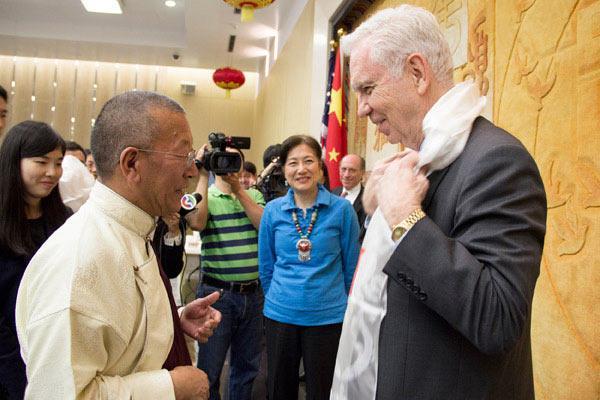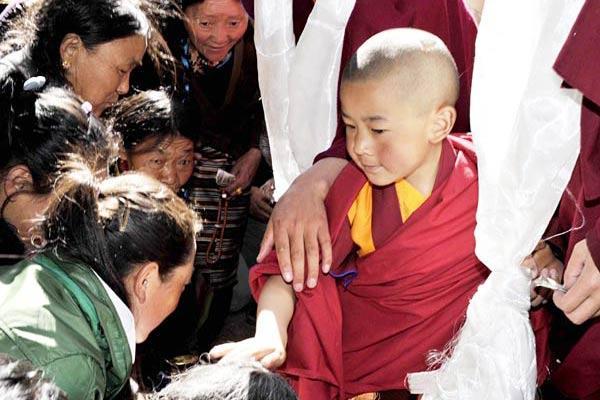Source:China Daily 2015-12-09

Rinpoche Shingtsa Tenzinchodrak (left) presents a Tibetan Kha Ta to US-China Partnerships Chairman Charles Foster (right) and while Foster's wife and actress Lily Chen Foster looks on. [Photo/China Daily]
Authorities are setting up a database of legitimate Rinpoches in China and will publish the information online, according to an official at the country's top political advisory body.
This will enable followers of Tibetan Buddhism to distinguish between real Rinpoches and fake ones, the official said.
Some fake Rinpoches have posed threats to national security, as they use money they collect to sponsor illegal or even separatist activities in Tibet.
This was disclosed by Zhu Weiqun, chairman of the Chinese People's Political Consultative Conference's Ethnic and Religious Affairs Committee to China Central Television during the weekend.
There have been reports of fake Rinpoches cheating people out of their savings or luring them into sexual activities using religious practice as an excuse.
Zhu's comments follow video footage of Baima Aose, a self-proclaimed Rinpoche, "ordaining" actor Zhang Tielin as a Rinpoche at a ceremony in Hong Kong in October. The footage has gone viral on the Internet.
Baima Aose said he became a Rinpoche after a Rinpoche at Katuo Monastery in Sichuan province's Garze Tibetan autonomous prefecture ordained him in Hong Kong in 2012.
On Sunday, the monastery denied his claim. It also said Baima Aose altered the contents of a letter in the Tibetan language addressed to him from another Rinpoche at the monastery to make people believe the letter certified his status as a Rinpoche.
He deceived Han Chinese followers who don't understand Tibetan and twisted the facts, damaging the monastery's reputation, according to a statement issued by the monastery.
Baima Aose, 39, is from Quanzhou, Fujian province. His original name was Wu Darong and he moved to Hong Kong when he was 8 years old. He is now chairman of the World Trade United Foundation, registered in Hong Kong, and Zhang, the actor, is the first vice-chairman.

Dedrug-Jamyangxerabpaldan (right), the reincarnated soul boy of the 5th Rinpoche Dedrug-Jampalgalsanggyatso, who passed away in March 2000, disperses his blessings on a recent day in Draipung Temple by touching people's heads. The temple is in Lhasa, capital of the Tibet autonomous region. The 7-year-old boy became the incarnated successor of the 5th Rinpoche following a 10-year search. [Photo provided to China Daily]
Tibetan Buddhism holds that the soul of a Rinpoche is reincarnated in a child. The selection procedure is strict and lengthy, and nearly all Rinpoches are from the Tibetan ethnic group.
Duoshi Rinpoche, a Rinpoche from Amdo county, Tibet, said the requirements to become a Rinpoche have to be learned during childhood. He said the ceremony Baima Aose performed was "just a joke" and Zhang had made a fool of himself.
Criminal activities involving fake Rinpoches still occur frequently, Duoshi Rinpoche said.
"I've heard that some monasteries in remote places even put the title of Rinpoche up for sale and trade it with wealthy businessmen," he added.
Xiaba Rinpoche, a Rinpoche in Aba Tibetan autonomous prefecture in Sichuan and executive director of the provincial Buddhist Association, said the database will soon start operating and will be open to the public.
He said the prevalence of fake Rinpoches can be attributed to people not having access to genuine ones, enabling opportunists to take advantage.
Li Decheng, director of the Religious Research Department at the China Tibetology Research Center, said followers of Tibetan Buddhism outside of Tibetan areas have limited understanding of the religion, such as the process required to ordain a Rinpoche.
This is why these followers are often deceived by fakes, Li said.
Certifying a Rinpoche
Rinpoches, also known as Living Buddhas or Tulkus, are deeply revered monks in Tibetan Buddhism, where it is believed that the soul of a senior Buddha is reincarnated in a child on his death.
There are 358 Rinpoches in the Tibet autonomous region, according to a white paper released by the State Council in September.
The reincarnation of a Rinpoche, which dates to the 13th century, must complete these procedures:
1. After the death of a Rinpoche, a ceremony is held to honor the body and pray for rebirth.
2. A search team headed by a Rinpoche is sent first to Lhamo Latso-the Oracle Lake-in Tibet to seek prophetic visions of the reincarnation.
3. Rinpoches are then sent in disguise to scour Tibet for special signs of a reincarnation. These include new mothers who have had unusual dreams and children who have special knowledge without being taught. Dozens of candidates are designated.
4. Final confirmation of the reincarnation is decided by the drawing of lots from a golden urn in the Jokhang Monastery in Lhasa.
5. The reincarnation process is completed after an enthronement ceremony.
In September 2007, the State Administration for Religious Affairs said all reincarnations of Rinpoches in Tibetan Buddhism must receive government approval.
Copyright © Xizang Daily & China Xizang News All rights reserved
Reproduction in whole or in part without permissions prohibited
Index Code: 藏 ICP 备 05000021 号
Producer: Xizang Daily International Communication Center